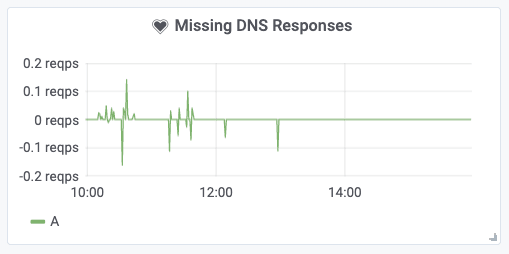Debugging and Monitoring DNS issues in Kubernetes
DNS is a common cause for outages and incidents in Kubernetes clusters. For real-world stories, swing by Kubernetes Failure Stories. How do you debug and troubleshoot DNS issues? How do you know a problem is related to DNS? This guide provides a step by step tutorial on how to systematically troubleshoot DNS issues in Kubernetes clusters. We will be using Hubble to identify and inspect DNS issues as well as set up monitoring so we can locate DNS issues early on to react even before incidents occur.
If you are not running Hubble yet, deploy it into your cluster by following the installation instructions.
Kubernetes DNS 101
In case you are not entirely familiar with how Kubernetes leverages DNS for service discovery, this section will give you a brief introduction. You can skip this section if you are already familiar with the DNS concepts of Kubernetes.
Kubernetes pods and services are assigned a transient IP address requiring a service discovery mechanism to be used to map the persistent service and pod name to the temporary IP address on the fly. To implement this functionality, Kubernetes assigns a fully qualified domain name (FQDN) to services and pods and configures pods to use CoreDNS. Pods are now able to look up service and pod names using DNS to retrieve the transient IP addresses.
Even though pods are assigned an FQDN as well, it is common practice to perform service discovery via the Kubernetes service name as shown in the diagram below:
Depending on the type of Kubernetes service, CoreDNS will respond with a ClusterIP or with a list of PodIPs directly (headless service). The pod connecting to the service can now initiate a connection to the returned IP address(es). For services of type ClusterIP, the Kubernetes networking layer will automatically translate connections to that ClusterIP to the IP of one of the pods chosen by the service to the PodIP of one of the pods selected by the service as illustrated by step (2) in the below diagrams:
If errors occur in this first step, these errors are typically referred to as DNS resolution errors or, more broadly, DNS issues. Errors during the second phase are generally referred to as network connectivity issues.
If you want to learn more about how Kubernetes uses DNS, see DNS for Services and Pods of the Kubernetes documentation.
How to monitor DNS errors in a Kubernetes Cluster
Network related errors can be challenging to troubleshoot as most applications will only log a generic timeout error when a network connection fails. Even worse, the cause for the failure can range from applications problems, network connectivity issues, misconfigured firewall rules, DNS issues, or a combination of the above and the error messages logged rarely provide sufficient context to differentiate between them.
To assist in monitoring and troubleshooting these errors, Hubble can be used to monitor all DNS traffic and to maintain metrics representing DNS error scenarios. The simplest DNS error scenario is if the DNS server returns an error directly to the application pod. Hubble maintains a metric to keep track of all such errors. You can use a metrics collection stack such as Prometheus and Grafana to collect and graph the DNS errors metrics of Hubble using the following query:
sum(rate(hubble_dns_responses_total{rcode!=\"No Error\"}[1m])) by (pod, qtypes, rcode)Using Grafana, we can generate a graph like the following, which will show the number of DNS errors occurring in the entire cluster at any time:
It is good practice to also set up a Prometheus alert on the number of DNS errors to receive an alert notification when the number of errors exceeds a certain threshold.
But, what if DNS resolution fails without the pod receiving a DNS error? This can happen if the network packets carrying the DNS response are being dropped. You can use Hubble to track a metric that shows the balance between DNS requests and DNS responses over time. Any significant in-balance of this graph indicates DNS requests remaining unanswered:
Understanding the presence of DNS errors is a vital first step. The next step is to track down the source of DNS errors and identify affected pods.
How to identify Pods receiving DNS errors
Knowing that DNS errors are occurring is excellent, but we need to know which application pods are being affected by DNS errors. Using the Hubble CLI, we can query the flow history on each node to identify the pods which have received DNS errors.
Hubble operates on a per-node basis, to simplify querying across nodes, we first define a bash function to execute a command inside all Hubble pods which are running as a DaemonSet in your cluster:
function hubble-cluster {
while read -r p; do
kubectl -n kube-system exec $p -- $*
done <<< "$(kubectl -n kube-system get pods -l k8s-app=hubble -o json | jq -r ".items[].metadata.name")"
}We can now use the hubble CLI to query the flow history to extract the names
of all pods which have received DNS errors in the last 10 minutes:
hubble-cluster hubble observe --protocol dns --since=10m -j | \
jq -r 'select(.l7.dns.rcode!=null) | .destination.namespace + "/" + .destination.pod_name + " " + .l7.dns.query' | \
sort | uniq -c | sort -r198 starwars/jar-jar-binks-59cdcc8dc4-hxl6w unknown-galaxy.svc.cluster.local.
198 starwars/jar-jar-binks-59cdcc8dc4-hxl6w unknown-galaxy.starwars.svc.cluster.local.
198 starwars/jar-jar-binks-59cdcc8dc4-hxl6w unknown-galaxy.cluster.local.
198 starwars/jar-jar-binks-59cdcc8dc4-hxl6w unknown-galaxy.The output in the above command illustrates a typical example of a particular
pod jar-jar-binks-59cdcc8dc4-hxl6w in namespace starwars consistently
failing to look up the FQDN unknown-galaxy while attempting to resolve all
the variants of the DNS suffix search list.
Tracking Pod Context in Metrics
The standard configuration will not attach any additional context, and the metric will describe the DNS errors and DNS response balance for an entire cluster or node. However, using the programmable metrics, Hubble can be configured to attach additional context to scope the metric by namespace, security identity, or even to individual pods. As an example, the following graph has been configured to label DNS errors with the pod name receiving the DNS error:
The Prometheus query used is:
topk(10,sum(rate(hubble_dns_responses_total{rcode!=\"No Error\"}[1m])) by (pod, destination))See Hubble Metrics Documentation for details on how to configure Hubble metrics to label accordingly.
Counting the number of DNS errors per pod helps to quickly identify which pods are subject to DNS resolution failures but doesn't yet tell us why the resolution is failing.
How to debug the DNS resolution of a pod
Continuing the troubleshooting process of the previous section, we can use Hubble to retrieve the detailed flow log and gain insights into the entire DNS resolution process. For this, we first define a couple of helper functions to identify the Hubble pod responsible for a particular application pod:
function node-of-pod {
kubectl -n $1 get pods $2 -o json | jq '.spec.nodeName'
}
function hubble-pod {
kubectl -n kube-system get pods -l k8s-app=hubble -o json | \
jq -r ".items[] | select(.spec.nodeName==$(node-of-pod $1 $2)) | .metadata.name"
}We can then extract the entire DNS resolution history of that pod as observed in the last minute:
kubectl -n kube-system exec -ti $(hubble-pod starwars jar-jar-binks-59cdcc8dc4-hxl6w) -- \
hubble observe --since=1m -t l7 --protocol DNS --pod starwars/jar-jar-binks-59cdcc8dc4-hxl6w -j | \
jq -r '.time + " " + .Summary'2019-12-17T15:23:12.681144228Z DNS Answer RCode: Non-Existent Domain TTL: 4294967295 (Query unknown-galaxy. A)
2019-12-17T15:23:12.678563485Z DNS Answer RCode: Non-Existent Domain TTL: 4294967295 (Query unknown-galaxy. AAAA)
2019-12-17T15:23:12.673809404Z DNS Query unknown-galaxy. A
2019-12-17T15:23:12.673437023Z DNS Query unknown-galaxy. AAAA
2019-12-17T15:23:12.671396412Z DNS Answer RCode: Non-Existent Domain TTL: 4294967295 (Query unknown-galaxy.cluster.local. AAAA)
2019-12-17T15:23:12.671358294Z DNS Answer RCode: Non-Existent Domain TTL: 4294967295 (Query unknown-galaxy.cluster.local. A)
2019-12-17T15:23:12.670369160Z DNS Query unknown-galaxy.cluster.local. A
2019-12-17T15:23:12.669797423Z DNS Query unknown-galaxy.cluster.local. AAAA
2019-12-17T15:23:12.667882766Z DNS Answer RCode: Non-Existent Domain TTL: 4294967295 (Query unknown-galaxy.svc.cluster.local. AAAA)
2019-12-17T15:23:12.666437147Z DNS Query unknown-galaxy.svc.cluster.local. AAAA
2019-12-17T15:23:12.666968986Z DNS Answer RCode: Non-Existent Domain TTL: 4294967295 (Query unknown-galaxy.svc.cluster.local. A)
2019-12-17T15:23:12.666305732Z DNS Query unknown-galaxy.svc.cluster.local. A
2019-12-17T15:23:12.663315418Z DNS Answer RCode: Non-Existent Domain TTL: 4294967295 (Query unknown-galaxy.default.svc.cluster.local. A)
2019-12-17T15:23:12.659744803Z DNS Query unknown-galaxy.default.svc.cluster.local. A
2019-12-17T15:23:12.659082489Z DNS Answer RCode: Non-Existent Domain TTL: 4294967295 (Query unknown-galaxy.default.svc.cluster.local. AAAA)
2019-12-17T15:23:12.658412636Z DNS Query unknown-galaxy.default.svc.cluster.local. AAAAThe output illustrates nicely how Kubernetes configures a Pod's DNS Config to
search a list of domain names and how each request fails for IPv4 (A) and
IPv6 (AAAA) with an error indicating that the corresponding DNS name could
not be found.
If the DNS server is returning any errors, you will see it in the output.
How to debug missing DNS responses
What if the symptom isn't DNS errors, but DNS responses are missing altogether?
Assuming that the pod starwars/jar-jar-binks-5bcd4b9b9f-cn7vc is failing to
perform DNS resolution, we can check for network packet drops from and to that
pod by running:
kubectl -n kube-system exec -ti $(hubble-pod starwars jar-jar-binks-5bcd4b9b9f-cn7vc) -- \
hubble observe --since=5m --pod starwars/jar-jar-binks-5bcd4b9b9f-cn7vc -t dropTIMESTAMP SOURCE DESTINATION TYPE VERDICT SUMMARY
Dec 17 15:37:32.171 starwars/jar-jar-binks-5bcd4b9b9f-cn7vc:45464 kube-system/coredns-5644d7b6d9-v5cv2:53(domain) Policy denied (L3) DROPPED UDP
Dec 17 15:37:32.171 starwars/jar-jar-binks-5bcd4b9b9f-cn7vc:45464 kube-system/coredns-5644d7b6d9-v5cv2:53(domain) Policy denied (L3) DROPPED UDP
Dec 17 15:37:27.166 starwars/jar-jar-binks-5bcd4b9b9f-cn7vc:45464 kube-system/coredns-5644d7b6d9-v5cv2:53(domain) Policy denied (L3) DROPPED UDP
Dec 17 15:37:27.164 starwars/jar-jar-binks-5bcd4b9b9f-cn7vc:45464 kube-system/coredns-5644d7b6d9-v5cv2:53(domain) Policy denied (L3) DROPPED UDP
Dec 17 15:36:43.680 starwars/jar-jar-binks-5bcd4b9b9f-cn7vc:42160 kube-system/coredns-5644d7b6d9-r9pfk:53(domain) Policy denied (L3) DROPPED UDP
Dec 17 15:36:43.680 starwars/jar-jar-binks-5bcd4b9b9f-cn7vc:42160 kube-system/coredns-5644d7b6d9-r9pfk:53(domain) Policy denied (L3) DROPPED UDPIn this example, the cause for DNS resolution is simple. The corresponding UDP packets are being dropped because the packets are being denied by the configured NetworkPolicies.
If the issue is still unclear, the entire network transaction can be retrieved to identify in which exact moment packets are being dropped:
hubble-cluster hubble observe --since=1m --pod starwars/jar-jar-binks-5bcd4b9b9f-k6ts9Dec 17 15:47:03.016 10.96.0.10:53(domain) starwars/jar-jar-binks-5bcd4b9b9f-k6ts9:51031 to-endpoint FORWARDED UDP
Dec 17 15:47:03.011 kube-system/coredns-5644d7b6d9-r9pfk:53(domain) starwars/jar-jar-binks-5bcd4b9b9f-k6ts9:51031 dns-response FORWARDED DNS Answer RCode: Non-Existent Domain TTL: 4294967295 (Query unknown-galaxy.starwars.svc.cluster.local. A)
Dec 17 15:47:03.011 starwars/jar-jar-binks-5bcd4b9b9f-k6ts9:51031 kube-system/coredns-5644d7b6d9-r9pfk:53(domain) dns-request FORWARDED DNS Query unknown-galaxy.starwars.svc.cluster.local. A
Dec 17 15:47:03.011 starwars/jar-jar-binks-5bcd4b9b9f-k6ts9:51031 kube-system/coredns-5644d7b6d9-r9pfk:53(domain) to-proxy FORWARDED UDPThe above example shows a complete transaction showing the UDP packet carrying the request, the parsed DNS request, the parsed DNS response, and the UDP packet carrying the DNS response delivered back to the endpoint. If any of them are missing, then you will know where the packet is being dropped.
Summary
DNS issues are a frequent cause of outages and incidents in Kubernetes clusters. DNS issues have typically been hard to detect and troubleshoot. In this guide, we have explored how Hubble using Cilium and eBPF can help to identify and track down DNS issues in your Kubernetes cluster.
To get started:
- Install Cilium using any of the Installation instrutions
- Deploy Hubble with the metrics dashboard configured: Setting up Hubble Metrics with Grafana
- Enable DNS visiblity
- Check out Cilium Slack for questions and answers









